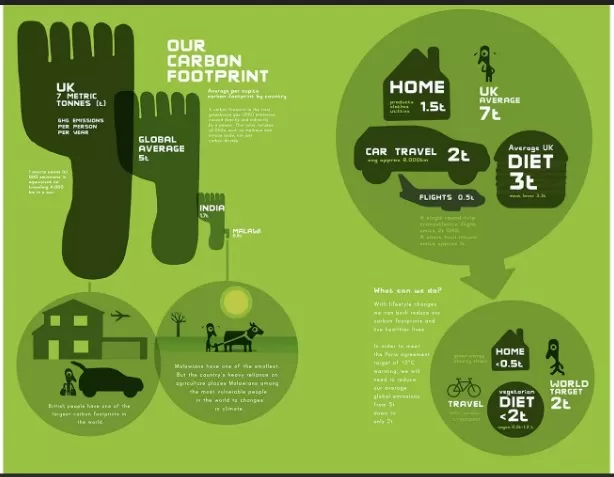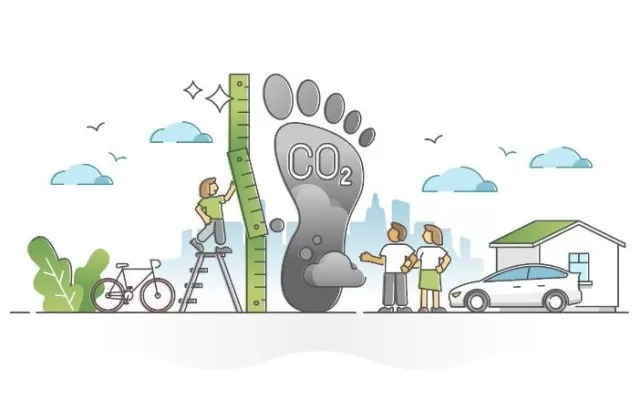Sustainable Home: Simple Carbon Footprint Reduction. If you’re eager to contribute to the effort of slowing down the impact of climate change, there are numerous small and straightforward changes you and your family can make within your home and daily activities.
By implementing these adjustments, you can collectively create a significant and enduring impact in reducing greenhouse gas emissions.Remember, even Small Changes can have a profound collective effect. By implementing these simple adjustments in your home and daily life, you can actively contribute to the global effort to combat climate change and create a more sustainable future for generations to come.
Understanding Carbon Footprint: Measuring and Reducing our Environmental Impact

The concept of a “carbon footprint” gained popularity in the mid-’90s, thanks to the pioneering work of William E.
Rees and Mathis Wackernagel. It serves as a crucial metric for quantifying the amount of greenhouse gas emissions generated annually, typically expressed in CO2-equivalent units.
By encompassing various aspects of our daily lives, such as home energy consumption, transportation choices, and the products we consume, the carbon footprint provides a comprehensive assessment of our environmental impact.
In essence, your carbon footprint represents the cumulative volume of greenhouse gases released into the atmosphere as a result of your individual actions.
It serves as a tangible measure of your contribution to climate change and the associated environmental consequences. By analyzing and understanding our carbon footprints, we can identify areas where we can make sustainable choices to reduce our impact on the planet.
According to the Nature Conservancy, the average American has an annual carbon footprint of approximately 16 tons of carbon-equivalent emissions, placing them among the highest emitters globally.
Comparatively, the global average per person stands at around 4 tons. However, to effectively mitigate the adverse effects of climate change, it is imperative that we collectively strive to lower the global average carbon footprint to below 2 tons per year by 2050, as suggested by the Nature Conservancy.
Reducing our carbon footprint requires a multifaceted approach that involves making conscious decisions and adopting sustainable practices in various aspects of our lives.
This can include embracing renewable energy sources, improving energy efficiency in our homes, opting for eco-friendly transportation alternatives, practicing mindful consumption, and supporting businesses that prioritize sustainability.
By taking proactive steps to reduce our carbon footprints, we contribute to the global efforts aimed at mitigating climate change and preserving the planet for future generations.
Understanding the concept of a carbon footprint empowers us to make informed choices and take responsibility for our environmental impact. Through collective action, we can move towards a more sustainable future, where carbon footprints are minimized, and the health of our planet is safeguarded.
Calculate Your Impact: Empowering Change through Carbon Footprint Assessment
To embark on the journey of reducing your carbon footprint, it is crucial to first understand the extent of your environmental impact.
Fortunately, numerous free online tools are available to help you accurately calculate your carbon footprint and gauge your contribution to greenhouse gas emissions. By harnessing the power of these tools, you can gain valuable insights into your current environmental footprint and identify areas where you can make sustainable changes. Here are a few reputable sources that offer online carbon footprint calculators:.
U.S. Environmental Protection Agency (EPA): The EPA provides a user-friendly carbon footprint calculator that allows you to estimate your emissions from various sources, including home energy usage, transportation, waste generation, and more.
By inputting your data, you can obtain a comprehensive assessment of your carbon footprint and explore ways to reduce it.
The Nature Conservancy: As a renowned conservation organization, The Nature Conservancy offers an online carbon footprint calculator tailored to individual lifestyles.
This tool considers factors such as energy consumption, travel habits, food choices, and shopping behaviors to provide personalized results and practical tips for emission reduction.
Carbon Footprint: Carbon Footprint is a specialized organization dedicated to helping individuals and businesses measure and reduce their carbon footprints.
Their online calculator enables you to input detailed information about your household or personal activities, enabling a comprehensive evaluation of your carbon emissions. The tool also suggests practical strategies to minimize your environmental impact.
By utilizing these online tools, you can take a proactive approach to calculate your carbon footprint accurately.
The data obtained will serve as a baseline for understanding your current impact on the environment and guide you in implementing effective strategies to reduce it. Remember, knowledge is power, and by quantifying your carbon footprint, you empower yourself to make informed choices and contribute to a more sustainable future.
Take the first step today by exploring these online resources and embarking on a journey towards a more environmentally conscious lifestyle.
Through small yet meaningful changes, collectively, we can make a significant positive impact on the health of our planet and future generations.
Audit Your Energy Use: Unveiling Opportunities for Energy Conservation

Taking stock of your energy consumption is a crucial step in identifying areas for improvement and implementing energy-saving measures.
You have various options to conduct an energy audit, ranging from hiring a professional to engaging with your local utility company or even performing a DIY assessment. The U.
S. Department of Energy offers a convenient self-assessment tool that can guide you in pinpointing opportunities to conserve energy within your home.
Here’s a breakdown of these audit methods:.
Professional Energy Audit: Enlisting the expertise of a professional energy auditor can provide you with a comprehensive evaluation of your home’s energy efficiency.
These auditors possess specialized knowledge and utilize advanced techniques and equipment to identify areas of energy loss and recommend tailored solutions. They may conduct a thorough inspection of your property, perform diagnostic tests, and offer insights into upgrading insulation, sealing air leaks, optimizing heating and cooling systems, and more.
Local Utility Company Assistance: Many utility companies offer energy audit services or can refer you to trusted professionals in your area.
Contact your local utility company to inquire about available programs or resources that can assist you in assessing your energy usage. They may provide personalized recommendations based on your energy consumption patterns, offer energy-saving incentives or rebates, and suggest energy-efficient products or services.
DIY Home Energy Audit: If you prefer a hands-on approach, conducting a do-it-yourself home energy audit is a viable option.
The U. S.
Department of Energy offers a user-friendly online self-assessment tool that guides you through a series of questions and tasks to evaluate your home’s energy efficiency. It covers areas such as insulation, heating and cooling systems, lighting, appliances, and more.
By following the prompts and providing relevant information, you can gain insights into potential energy-saving opportunities and prioritize improvements accordingly.
Regardless of the method you choose, conducting an energy audit allows you to identify specific areas where energy is being wasted and offers practical solutions for improvement.
By implementing the recommended changes, such as sealing air leaks, upgrading to energy-efficient appliances, optimizing insulation, or adjusting thermostat settings, you can reduce your energy consumption, lower utility bills, and decrease your carbon footprint.
Remember, auditing your energy use is a proactive step towards a more sustainable lifestyle.
It empowers you to make informed decisions about energy conservation, ultimately contributing to a greener future.
Upgrade Your AC: Enhancing Efficiency and Saving Energy
Upgrading your air conditioning (AC) system can not only improve your comfort but also lead to substantial energy savings and environmental benefits.
According to an analysis of energy data conducted by Sense, a prominent smart home energy company, approximately 20 percent of Americans currently have inefficient HVAC systems, resulting in an average additional cost of $882 per year to cool their homes. This cost is nearly four times higher than households with more efficient AC systems in similar homes.
The study further highlights that the top 20 percent of homes with the highest cooling usage account for 45 percent of all cooling consumption nationwide.
By updating these less-efficient homes with more energy-efficient AC systems, it is estimated that the United States could save 8 percent of its residential electricity usage overall and eliminate nearly 52 tons of CO2 emissions annually.
Upgrading your AC system can be a worthwhile investment with long-term benefits.
Here are some steps you can take to enhance efficiency and Save Energy:.
Assess your current AC system: Determine the age, condition, and energy efficiency rating of your existing AC unit.
Older systems tend to be less efficient, so upgrading to a newer model can provide significant energy savings.
Look for energy-efficient models: When selecting a new AC system, opt for units with high energy efficiency ratings, such as those with ENERGY STAR certification.
These systems are designed to consume less energy while delivering optimal cooling performance.
Proper sizing and installation: Ensure that the new AC system is properly sized for your home to avoid energy wastage.
Improperly sized units may cycle on and off frequently, leading to inefficiencies. Professional installation is crucial to guarantee optimal performance and energy efficiency.
Regular maintenance: Schedule regular maintenance for your AC system to keep it running efficiently.
Clean or replace filters as recommended, and have a professional inspect and tune up the system periodically.
Smart thermostats and zoning: Consider installing a smart thermostat, which allows you to control and optimize your cooling settings remotely.
Additionally, implementing zoning techniques can help target cooling efforts to specific areas of your home, further reducing energy consumption.
By upgrading your AC system and adopting energy-saving practices, you can enjoy increased comfort, lower energy bills, and contribute to reducing CO2 emissions.
Additionally, local utility programs or government incentives may be available to support your AC upgrade, making it an even more financially feasible and environmentally responsible choice.
Remember, investing in an energy-efficient AC system is not only beneficial for your household but also plays a significant role in building a more sustainable future.
Lower Your Cooling Load: Strategies for Energy Efficiency and Comfort

Reducing the cooling load on your home can significantly decrease your reliance on air conditioning, leading to energy savings and enhanced comfort.
By implementing a few simple changes, you can optimize your home’s thermal performance and create a more energy-efficient environment. Here are some strategies to consider:.
Plant shade trees and shrubs: Strategically planting trees and shrubs around your home can provide natural shade, reducing the direct sunlight that enters your windows.
This helps to lower indoor temperatures and lessen the workload on your air conditioner. Opt for deciduous trees that provide shade in the summer while allowing sunlight through in the winter.
Utilize window coverings: Close draperies, curtains, or window shades on the sunny side of your house during the day to block out heat from the sun.
This prevents excess heat gain and keeps your home cooler. Consider using reflective or light-colored window coverings for better heat reflection.
Enhance ventilation with fans: Whole-house fans or portable fans can Increase ventilation and improve air circulation, promoting a cooler indoor environment.
Whole-house fans draw in cooler air during the evening or early morning, reducing the need for air conditioning. Portable fans can be used to create localized cooling or enhance air movement throughout the house.
Install thermal-efficient windows and doors: Upgrading to energy-efficient windows and doors with proper insulation helps to prevent heat transfer and minimize air leaks.
Look for windows and doors with low-emissivity (low-E) coatings and adequate weatherstripping to improve thermal performance.
Consider cooling roofing materials: When it’s time to replace your roof, explore the option of reflective or cooling roofing materials.
These materials are designed to reflect more sunlight and absorb less heat, reducing the heat load on your home. This can contribute to lower indoor temperatures and lessen the demand for air conditioning.
Implementing these changes not only reduces your cooling load but also enhances energy efficiency and creates a more sustainable living space.
Lowering your reliance on air conditioning helps to conserve energy and reduce greenhouse gas emissions associated with cooling systems.
Remember, combining these strategies with an energy-efficient AC system and regular maintenance can further optimize your home’s cooling efficiency.
By embracing these measures, you can enjoy a more comfortable and environmentally friendly living environment while saving on energy costs.
*The information is for reference only.